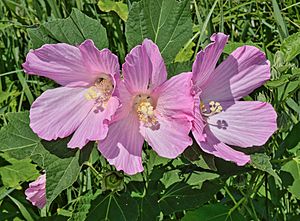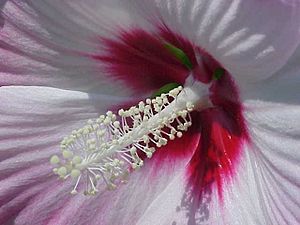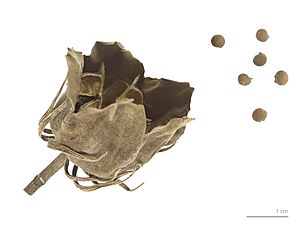Swamp rose mallow facts for kids
Quick facts for kids Swamp rose mallow |
|
|---|---|
 |
|
| Rose mallow blooming in Point Pelee National Park (Ontario, Canada). | |
| Conservation status | |
| Scientific classification | |
| Genus: |
Hibiscus
|
| Species: |
moscheutos
|
The rose mallow (scientific name: Hibiscus moscheutos) is a beautiful flowering plant found in wet areas. It's also known by names like swamp rose-mallow or crimsoneyed rosemallow. This plant is a type of perennial which means it grows back year after year, even after cold winters. It can form large groups of plants in places like wetlands.
The leaves of the rose mallow can look different from plant to plant, but they often have a triangle shape with up to three parts. You can find this plant growing naturally in the eastern United States, from Texas all the way to the Atlantic coast. It also grows north into southern Ontario, Canada. The flowers come in many colors, from pure white to a deep pink. Most of them have a dark red spot in the middle, like an "eye."
Contents
What Eats the Rose Mallow?
The rose mallow is an important food source for several insects. It acts as a "host plant" for their larvae (which are like baby insects). This means the larvae eat the plant's leaves. Some of the insects that use the rose mallow as a host include the common checkered skipper butterfly, the gray hairstreak butterfly, the Io moth, and the pearly wood nymph moth.
Growing Rose Mallow in Your Garden
This plant is very popular for gardens, especially in areas with wet soil or near water features. You can grow new rose mallow plants in a few ways. One way is by planting its seeds. Another way is to divide the plant's roots in winter when it's not actively growing. Sometimes, you can also grow new plants from cuttings taken from the stems.
Many new types of Hibiscus plants have been created by plant nurseries. These are often hybrids, which means they are a mix of different native North American Hibiscus species. These plants are pretty and also help local wildlife, like birds and insects that feed on nectar.
Different Types of Rose Mallow
Many of the Hibiscus plants that can handle cold weather are hybrids of H. moscheutos and other related species. These include H. palustris, H. coccineus, H. laevis, and others. Plant breeders often mix the pollen from different parent plants to create new types with special colors or shapes. This helps them get the best new varieties.
Protecting the Rose Mallow
In Canada, the rose mallow is listed as a "species of special concern." This means that while it's not in immediate danger of disappearing, experts are keeping a close eye on it. They want to make sure its habitats are protected so it can continue to thrive. This protection is part of Canada's Species at Risk Act, which helps conserve plants and animals that might be at risk.
See also
 In Spanish: Hibiscus moscheutos para niños
In Spanish: Hibiscus moscheutos para niños




